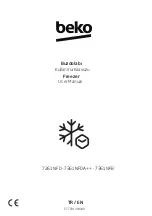
u
To store frozen food directly on the shelves: pull the drawer
forwards and lift it out.
5.9 Shelves
u
To remove the shelf: lift up at the front
and pull out.
u
To put the shelf back: simply push in as
far as it will go.
5.10 VarioSpace
Apart from being able to remove
the drawers, you can also
remove the shelves, creating
space for large items of frozen
food. Poultry, meat, large pieces
of game and high bakery prod-
ucts can be frozen in one piece
and prepared.
u
The maximum load of frozen
food for the drawers is 25 kg
each and for the shelves
35 kg each.
5.11 Information system*
Fig. 9
(1) Ready meals, ice cream
(4) Sausage, bread
(2) Pork, fish
(5) Game, mushrooms
(3) Fruit, vegetables
(6) Poultry, beef / veal
The figures indicate the storage time in months for several
types of frozen food in each case. Storage times given are
guide times.
5.12 Drawer for herbs and berries
In the drawer for herbs and berries you can freeze, berries,
herbs, vegetables and other small items of food without them
sticking together. Items being frozen will largely retain their
shape, and it will be easier to remove exactly the right quantity
later on.
5.12.1 Using the special drawer for herbs and
berries
u
Spread the items out loosely
in the special drawer for herbs
and berries.
u
Allow the food to freeze
through for 10 to 12 h.
u
Transfer the frozen food to
freezer bags or containers.
u
Store freezer bags or containers in a drawer.
u
To thaw the items, spead them out loosely again.
5.13 Cold storage accumulators*
The cold storage accumulators prevent the temperature from
rising too fast in the event of power failure.
5.13.1 Using cold storage accumulators*
u
Place the cold storage accu-
mulators in the special drawer
for herbs and berries to save
space.
u
Place the frozen cold storage
accumulators on the frozen
food in the upper front area of
the freezer compartment.
6 Maintenance
6.1 Defrosting with NoFrost
The NoFrost system automatically defrosts the appliance.
The moisture condenses on the evaporator, is periodically
defrosted and evaporates.
u
The appliance does not have to be manually defrosted.
6.2 Cleaning the appliance
WARNING
Risk of injury and damage as a result of hot steam!
Hot steam can lead to burns and can damage the surfaces.
u
Do not use any steam cleaners!
NOTICE
Incorrect cleaning damages the appliance!
u
Do not use cleaning agents in concentrated form.
u
Do not use any scouring or abrasive sponges or steel wool.
u
Do not use any sharp or abrasive cleaning agents, nor any
that contain sand, chloride or acid.
u
Do not use chemical solvents.
u
Do not damage or remove the type plate on the inside of the
appliance. It is important for the customer service.
u
Do not pull off, bend or damage cables or other compo-
nents.
u
Do not allow any cleaning water to enter the drain channel,
ventilation grille or electrical parts.
u
Please use soft cleaning cloths and a universal pH-neutral
cleaning agent.
u
Please use cleaning and care products suitable for contact
with foodstuffs in the appliance interior.
u
Empty appliance.
u
Pull out the power plug.
u
Clean plastic outer and inner surfaces with lukewarm
water and a little washing-up liquid.
Do not apply stainless steel cleaning agent to glass or plastic
surfaces to prevent them from being scratched. Darker areas at
the beginning and quite an intensive colour of the stainless
steel surface are normal.
Maintenance
* Depending on model and options
9






























